Quinoa: medicinal properties and contraindications
Quinoa is an annual herbaceous plant belonging to the Marev family. There are many types of this crop, which are in the form of grass, shrubs or shrubs. It is generally accepted that this is an absolutely useless weed crop, so it is destroyed in vegetable gardens or gardens. But in ancient times, it was valued among the peasants and, as history says, often saved people from starvation. This is due to the fact that the plant was used for food. It is worth noting that the benefits of quinoa are invaluable, because it contains many valuable components. More on this.
- Chemical composition
- How it looks and where it grows
- Kinds
- Collection and storage
- Useful properties of the quinoa
- Herb quinoa in folk medicine
- How to prepare an ointment against mastopathy
- Cooking use
- Soup
- Cutlets
- Casserole
- Porridge from quinoa seeds
- Use in cosmetology
- Can rabbits be given a quinoa
- Contraindications
Chemical composition
Despite the fact that quinoa is a simple and unpretentious plant, its composition revealed the presence of 17 types of amino acids, which in the human body play an invaluable role. It is also important that the grass contains a large amount, about 30%, of protein compounds - proteins. Therefore, it is believed that the plant in this matter can compete even with meat.
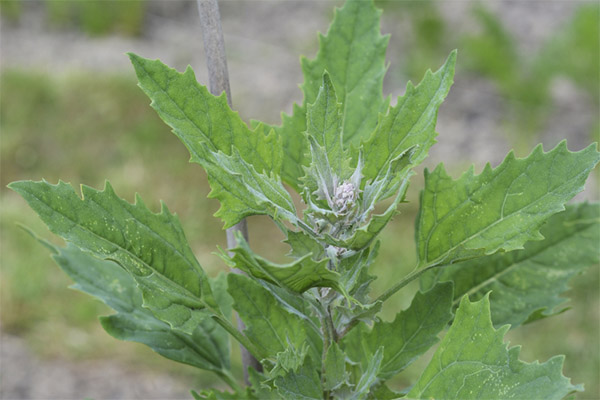
The chemical composition of the quinoa is represented by the following components:
- alkaloids;
- about 40% fiber;
- fats
- carbohydrates;
- oxalic and nicotinic acids;
- B vitamins;
- essential oils in the form of saponin;
- vitamins A, C, E, PP;
- macro- and microelements, such as manganese, potassium, calcium, sodium, zinc, phosphorus, iron.
The foliage of the plant includes not only as many as 17 types of amino acids, but also ascorbic acid and carotene.
How it looks and where it grows
Culture is usually associated with weeds. But this is wrong, because the plant can also be used as a vegetable or medicine, which has absolutely no side effect.
Most often it can be found in gardens, on fields or vacant lots, in ravines, as well as on the banks of water bodies. It is worth noting that this is not only a wild plant, it is often grown as a cultivated one. It is distributed throughout the globe. But the largest number used for gastronomic purposes is observed in Australia and the United States.
Kinds
Consider the most famous types of culture:
Garden
An annual plant characterized by an erect stem with a faceted and branched structure. The height can vary from 60 to 180 cm. The foliage has a different shape, but always elongated, with notches at the edges. The taste of green foliage is sour. Color can be both dark green and red burgundy. The lower side of the foliage has a peculiar milky hue. Flowering occurs due to the formation of panicled or spikelet inflorescences, painted in red or green. The beginning of flowering occurs in June, July or August. This species is grown as a vegetable or ornamental plant.
Wild
This is an annual plant, reaching a height of 30 to 70 cm. The trunk is both erect and creeping. Shoots can be horizontal or directed to the top. On long branches, film-like bloom is observed. Foliage can have the most diverse form: triangular, egg-shaped, with the presence of notches along the edges. The shade of green is gray-green, which sometimes changes to red. The flowers are collected in a kind of tangles located in the axils of the leaves.
Tatar
An annual plant that can grow in growth by only 10 cm or reach a height of 1 m. The trunk of the grass is both upright and lying. The foliage has an elongated oval, narrowed shape, distinguishing by the presence of notches along the edges. The plate is covered with small villi. Flowering culture lasts from June to October.Flowers are represented by spikelet inflorescences framed by small foliage below. This plant is used as a food or feed product.
Head
An annual growing up to 60 cm in height. The stem has a creeping shape. The color is green, which is replaced by red by autumn. The foliage is in the shape of a triangle or oval. Sometimes notches appear on it. Flowering continues from June to August. Flowers form into small tangles, painted in a greenish tint.
Spear-shaped
An annual culture that grows 1 m high. The trunk is bare and branched. The foliage has a horizontal arrangement and a plain green color. The shape is triangular spear-shaped, sometimes with serrations. The flowers are collected in tangles that form spikelet inflorescences.
Sprawling
The height of the grass can vary from 30 cm to 150 cm. The trunk is an erect type, branched. The foliage located in the bottom row has the shape of an uneven rhombus or spear. Leaves are painted in green. Flowers are collected in spikelet inflorescences of a green shade. The plant is considered not only a fodder, but also a food crop.
Collection and storage
In order to prepare the quinoa, it is imperative to predict the flowering period. It was at this time that the plant contained the largest part of the useful and nutritious components that are present in the stems, and in the foliage, and in the inflorescences.
After harvesting, the plant must be dried in the open air, and then sent for storage to a dry room. Storage containers should be glass. Often, fabric bags are also allowed for this.
Useful properties of the quinoa
It is proved that quinoa improves the digestive processes of the body, supports the health of the kidneys at the required level, and also has a strengthening effect on the cardiovascular system. In addition, it can also have the following beneficial effect:
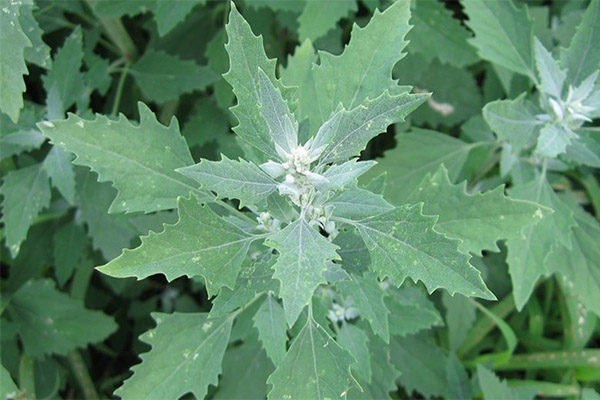
- Strengthening bones due to the contained components - magnesium, potassium, phosphorus. In addition, the plant has a high calcium content, which favorably affects bone tissue, as well as a high concentration of protein, which takes an active part in the process of muscle formation. Regular use of the component avoids the development of a disease such as osteoporosis.
- The heart and blood vessels also do not stand aside during the beneficial effects of culture. Due to the presence of iron in the composition, the number of red blood cells is maintained at the level necessary for the body, the hemoglobin level is normalized. Fiber and potassium are able to strengthen the heart, as well as remove harmful cholesterol from the blood, normalize blood flow.
- Due to the fact that the plant is a natural source of zinc, iron and copper, the work of the brain improves, and the state of the nervous system is also brought back to normal.
- By preparing funds based on this plant, you can cope with many diseases that occur in the oral cavity, inflammation of the gums caused by various factors and the elimination of halitosis. In addition, such funds are recommended for use in diseases of the upper respiratory tract.
- Culture is considered an excellent diuretic. Its action is to stimulate urination, cleanse the kidneys and remove salts, toxins, and water from the body.
- The antispasmodic properties of the plant are very effective when it is necessary to relieve menstrual pain.
- Due to the antioxidants present in the plant, the aging process slows down, which leads to the intensive production of natural collagen. Vitamin C is also actively involved in the production of connective tissue and thus prevents the appearance of wrinkles.
In addition to all of the above, due to the presence of antioxidants in the composition, the occurrence of cancer is prevented, as well as the neutralization of free radicals that provoke destructive processes in the cells.
Herb quinoa in folk medicine
Quinoa is a herb with a number of medicinal properties: anti-inflammatory, expectorant, antispasmodic, soothing. Due to the fact that a fresh plant contains a lot of fiber, it acts as a natural sorbent, which removes a large amount of toxins and toxins with regular use in its original form, which puts the gastrointestinal tract in order. Tea based on quinoa is recommended for use with severe menstrual pain.
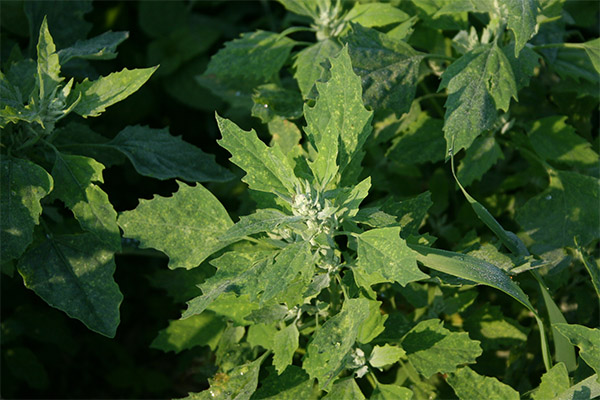
Quinoa infusion is used for stress on the nervous system and headaches. In addition, this tool effectively gargles with sore throat. Often it is used to prepare lotions for skin diseases of various types.
Preparation of the infusion consists of the following steps:
- Grind the dried quinoa and pour 1 tablespoon into a glass.
- Pour 200 ml of boiling water.
- Cover the container and insist for 2 hours.
- After the set time has passed, strain the composition.
Take the prepared composition at least 4 times a day. The amount of funds varies from 1 to 2 tablespoons. It is important that this be done 20 minutes before a meal.
A decoction of quinoa is applicable for dry cough or bronchitis. It is important to remember that you should not abuse the product with a tendency to constipation, since it also has a fixing effect. Preparation of a decoction consists of the following steps:
- Pour dried and chopped quinoa in a convenient container in an amount of 20 g.
- Pour 200 ml of water brought to a boiling point.
- Send the container with the added contents to the stove and cook for 20 minutes over low heat.
- Remove from the stove and insist for another half an hour.
- Strain.
Take the prepared product at least 3 times a day after meals. The amount of a single dose will be ½ cup.
To prepare a decoction based on the seeds of a spreading quinoa, the following steps will be required:
- Dry seeds in the amount of 1 tablespoon pour 300 ml of water, brought to a boiling point.
- Wait for the mass to cool and strain.
Treatment with the prepared remedy consists in a daily three-time intake of 2 tablespoons of the decoction. The course lasts 1 week.
In order to prepare alcohol tincture based on quinoa, you need to perform a number of the following actions:
- Chopped grass in the amount of 2 tablespoons pour 200 ml of alcohol or vodka.
- Send the composition to a dark place for 2 weeks.
- From time to time, be sure to shake the composition.
- After the set time has passed, strain.
Take the prepared medicine daily for 1 teaspoon.
Quinoa juice is effective for both external and internal use. First of all, it should be used for disinfection and healing of wounds. In order to cook it, it is necessary to prepare fresh foliage of a quinoa and pass it through a meat grinder. Fold the resulting puree in gauze or another piece of a suitable clean cloth and squeeze well. The juice is ready. Moisten a gauze dressing and apply to the affected area of the skin. Also, such a tool is effective in various skin diseases.
For internal use, it is necessary to fill a glass with juice halfway, add 1 teaspoon of honey and drink daily. This is a very healthy drink that strengthens the immune system.
A decoction based on quinoa can be used to treat thrush. Preparation of syringes is as follows:
- Shredded grass in the amount of 4 tablespoons put in a container and pour 200 ml of water, brought to a boiling point.
- Send the container to the stove and boil the composition over low heat for 15 minutes.
- Remove from the stove, cool and squeeze the raw materials, then strain the liquid and dilute it with 1 liter of boiled water.
The resulting composition is used for douching with thrush. But the received remedy can also be taken inside. With exacerbation of gout - this is an indispensable tool, which you need to use 2 to 4 times a day for ½ cup.
For the treatment of dry cough, it is necessary to brew 1 teaspoon of chopped quinoa in 200 ml of water brought to a boiling point. Insist for half an hour, and then strain. Before use, add 1 teaspoon of honey. Drink the drink three times a day. The action of the remedy is that quinoa acts on sputum and dilutes it, and honey helps to eliminate.
With radiculitis, it is recommended to use fresh leaves of the culture, which must be steamed, and then applied to the sore spot. Then wrap the affected area with grass in a warm cloth and leave overnight. Such a compress will relieve the inflammatory process and relieve pain.
The course of treatment for various cardiovascular diseases is also recommended to supplement with quinoa. You can take the plant fresh as a product or prepare a decoction:
- Bring 300 ml of water to a boiling point, and then brew 2 tablespoons of chopped quinoa in it.
- Insist the composition under a closed lid for half an hour.
- Strain.
- Divide the resulting liquid into 3 doses.
The course of treatment will be at least 14 days.
How to prepare an ointment against mastopathy
This method of treatment is often used in traditional medicine, but if in doubt, you should consult a doctor about the use of this tool.
Step-by-step preparation of ointment:
- Collect the green mass of the plant, which may include foliage, stems and inflorescences, weighing 1 kg.
- Wash thoroughly under cold running water and then lay on a linen towel to dry.
- 500 g salted pork fat, remove salt, cut into small pieces and turn into porridge using a meat grinder.
- The quinoa, which has already completely dried out, is also crushed using a meat grinder.
- Thoroughly mix the resulting mass and send for storage in the refrigerator.
Do not smear the body with the ointment obtained. Application requires the following recommendations:
- Take a blank sheet of paper and apply the prepared ointment on it evenly.
- Apply treated paper to the breast area.
- Press the compress to your chest with a warm scarf or woolen scarf.
- Try to keep the compress until the fat is completely absorbed into the skin.
Immediately after removing the compress, wash the body with soap.
It is recommended to continue treatment until all solid areas have disappeared. In no case should you use polyethylene for the procedure.
Cooking use
The taste qualities of quinoa are peculiar. Boiled seeds taste similar to buckwheat. Foliage does not have pronounced taste characteristics, as well as aroma. This is the advantage of this culture. When added to various dishes, the ingredient practically does not change their taste, but significantly increases the nutritional value.
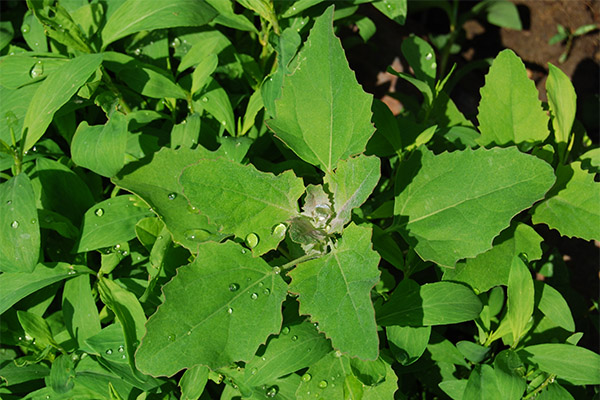
But quinoa perfectly absorbs other tastes and aromas, like some types of mushrooms. Therefore, in cooking, the product is used with many spices and seasonings. In order to give a pleasant taste to the quinoa, you can use parsley, garlic, onions, bay leaves.
In cooking, not only the green mass of the plant is used, but also the seeds. Quinoa is added to various salads, soups, stewed like cabbage, fried in a pan with the addition of vegetable oil, used to decorate dishes for the festive table. Porridge is cooked from seeds, like any cereal, they are also crushed and mixed with flour, so that later they can be used for baking bread products, pancakes.
It is worth noting that quinoa is compatible with almost the entire list of products.
Soup
Soup prepared on the basis of quinoa is very aromatic, tasty and healthy. To prepare it, you must perform the following steps:
- Pour 300 ml of purified water into the pan, send to the stove and bring to a boiling point.
- Cut into 3 small cubes any mushrooms and send them to the pot with boiling water.
- Peel medium-sized potato tubers in the amount of 2 pieces, wash, divide into medium-sized cubes and send to the pan.
- Peel medium-sized carrots, wash, cut into small cubes and pour into boiling water.
- Wash and finely chop 100 g of young quinoa leaves, 40 g of sorrel, 20 g of green onions.
- After the potatoes in the pan reach readiness, send prepared greens there.
- Boil the soup for a few more minutes.
- Add the necessary spices to it, such as cilantro, oregano, coriander, basil, fresh dill.
Immediately before serving, season the soup with sour cream. It is recommended to serve the dish in tandem with mustard.
Cutlets
This dish is ideal for fasting people or vegetarian lovers. In order to cook cutlets, you need:
- Rinse the leaves of quinoa in an amount of 150 g, and then finely chop.
- Put them in a pan, add salted water to taste, add 30 g of oatmeal, put on the stove and cook until you get ready porridge.
- Remove from stove and leave to cool.
- From the resulting porridge, form patties, roll them in breadcrumbs and fry in vegetable oil until a brown crust is obtained on both sides.
Such cutlets can not only be fried, but also steamed.
Casserole
To prepare an unusual and tasty casserole, you will need to perform a number of the following actions:
- Wash the garden quinoa in an amount of 700 g, and then boil it in salt water to taste for 10 minutes.
- Throw it in a colander and allow time for the release of excess moisture and cooling. Then chop the boiled greens with a knife.
- Boil 50 g of vermicelli in salted to taste water, without waiting for it to boil. Drain and rinse under running cold water.
- Melt butter in a separate container in an amount of 75 g. Add 125 g of wheat flour to it. Fry a little, and then add vermicelli and chopped boiled quinoa. Simmer for 5 minutes.
- Remove from heat and slowly add 300 ml of warm milk, not forgetting to mix the composition at the same time.
- Beat 2 chicken eggs and 50 g ham, chopped in the form of small straws.
- Add salt and pepper to taste, mix the composition.
- Grease a suitable baking sheet with butter, sprinkle with breadcrumbs and put the prepared composition on it. Grate 50 g of feta cheese on top.
- Bake for 40 to 50 minutes. The dish will be ready as soon as a delicious brownish crust appears.
Porridge from quinoa seeds
Step-by-step preparation of porridge:
- Grease a pot with a thick bottom with vegetable oil, heat on a stove.
- Dice 300 g of pork and put in a saucepan. Fry until golden brown, season with salt and pepper.
- Peel 2 onions, and then cut into cubes and send to the meat in a pan. Simmer for a few minutes.
- Now peel 2 medium-sized carrots, wash, also cut into cubes and pour into a pan. Simmer the composition for several minutes.
- Remove the peel from a medium-sized zucchini, cut it into cubes and also send it to the container. Add 50 g of fresh green peas immediately.
- Stir the composition and add a little dried parsley and dill.
- Add 100 g of quinoa seeds and pour in water so that it only covers the ingredients in the pan. Cook until tender.
Use in cosmetology
Quinoa is also applicable in cosmetology. It is known that it is able to have a powerful anti-aging effect on the skin. Effective masks of moisturizing and nourishing action are made on the basis of this herb, which tone the skin and increase its elasticity.
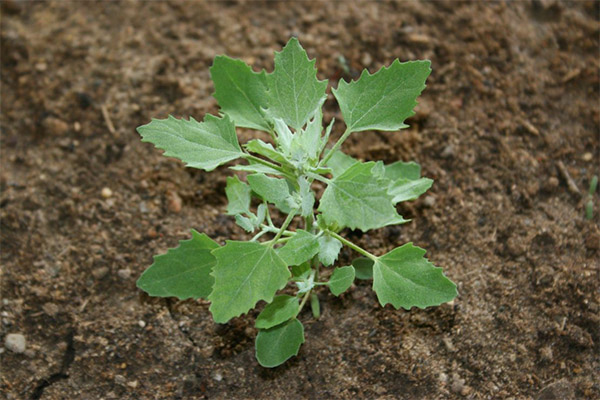
The infusion of this herb is often used for washing. It is recommended to wash your face twice a day, and after a month the skin will shine with youth and beauty.Preparing this product is very simple: pour the available amount of grass with boiling water, wrap the container in a warm blanket and infuse the composition for 1 ½ hours. After that, you can immediately use the tool.
The preparation of the most popular mask based on the quinoa, which is often called the "Slavic secret of youth", consists in the following actions:
- Pour 100 ml of water brought to a boiling point, 1 teaspoon of chopped dry quinoa.
- Leave to insist for half an hour.
- Strain through a sieve and add milk to the composition, based on a 1: 1 ratio.
- Moisten in the prepared composition wipes and apply to pre-cleansed face skin.
- Leave on for 20 minutes. At this time, it is worth putting off all affairs and lie down.
In order to make such a mask drier, sour cream or yogurt is often added instead of milk.
Judging by the reviews, a remedy from quinoa seeds prevents skin aging. You can prepare it as follows:
- Boil 2 tablespoons of quinoa seeds in soy milk. Leave to cool completely.
- In a convenient container, combine 2 egg yolks, 3 teaspoons of natural yogurt and 2 drops of mimosa essential oil with boiled seeds.
- Interrupt the composition by applying a blender.
Apply the resulting mask in an even layer on the skin of the face and neck. The exposure time is 20 minutes. Then rinse with warm water.
Facial Nutrient:
- In a total capacity, combine 1 teaspoon of quinoa decoction with 1 teaspoon of freshly squeezed carrot juice.
- Add 1 teaspoon of honey. Stir until a homogeneous mass is obtained.
Apply the composition to the face with a special brush. Rinse this product with lightly brewed black tea, pre-chilled. When using this cosmetic product 2 times a week, the skin will have a slight tanning effect.
A well-moisturized face mask has also proven itself. Her cooking recipe:
- Grate a fresh cucumber.
- Put 2 tablespoons of chopped vegetable in a separate container and add 1 tablespoon of the decoction based on the quinoa to it.
- Add ½ tablespoon of olive oil and mix thoroughly.
Apply the resulting mask to the face and leave for 10 minutes. To wash off the mask, prepare a weak brewing of green tea or a decoction based on parsley. After 5 minutes, wipe the face with an ice cube or gently wash with cool water.
Hair Benefits
The grass contains many components that have a beneficial effect on the hair. Thanks to the proteins of plant origin contained in the composition, the curls are cleansed and nourished. Amino acids protect and strengthen the roots, provide the necessary nutrition for hair follicles.
Due to the fact that the composition of the culture includes iron, phosphorus and potassium, the amount of moisture for the skin of the head is provided at the proper level. Therefore, dry skin in this area and peeling disappears.
Thanks to vitamin E, the effect of which is to supply natural oils, the hair is naturally moisturized, which prevents brittleness and confusion.
In order to prepare a mask that strengthens the hair structure, you must:
- Grind 2 tablespoons of dried quinoa.
- Pour grass in a convenient container with 200 ml of water brought to a boiling point.
- Insist composition for 30 minutes. Then strain.
- Add 1 tablespoon of burdock or castor oil.
- Stir until smooth.
Rub the finished mask into the root system of the hair and leave for half an hour. After a specified time, wash your hair with shampoo.
Can rabbits be given a quinoa
For rabbits, quinoa is not the most delicious treat, because, according to experienced farmers, they eat it reluctantly. But this does not mean that the grass does not bring benefits.As mentioned earlier, the culture contains a large number of useful components that will have a positive effect for rodents and strengthen immunity. With moderate use, the product will improve the digestive system of rabbits. Acceptance of the product for animals is allowed in small quantities and not daily, but only several times a week.
How to feed rodents with a swan
In order to feed rabbits, it is recommended to use only young quinoa leaves. This is due to the fact that they contain the largest number of useful components. Also, for collection, you can choose the time at which the flowering process of the plant begins. The diet is also recommended to supplement with other herbs, such as burdock, dandelion, nettle, plantain.
The rabbit quinoa can be given both fresh and dried. Any case requires the introduction of a small amount of a new product in the diet. Only then it is necessary to gradually increase the portion and observe the reaction of the animal.
Contraindications
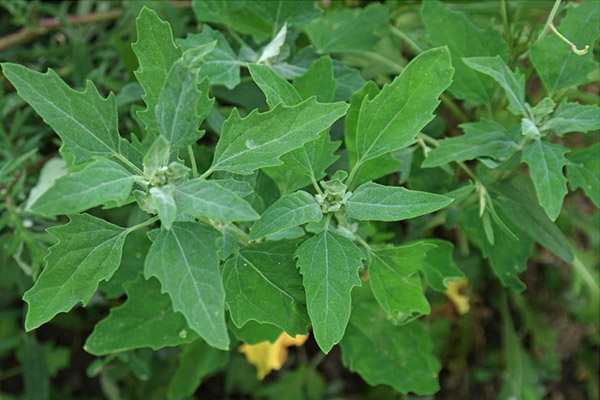
In rare cases, quinoa can harm the body. But still there are some diseases in which the consumption of plants is strictly prohibited:
- individual intolerance to individual components of the product;
- low blood coagulation;
- some diseases of the gastrointestinal tract, such as colitis, ulcers, gastritis;
- urolithiasis disease;
- tendency to bleeding.
There is also the likelihood of an overdose, which can lead to diarrhea, vomiting and digestive disorders. This can serve as an impetus for the formation of peptic ulcers. So the use of quinoa must be approached with extreme caution.
Quinoa is a grass with many positive properties, which it owes to the presence in its composition of a large number of useful substances. The culture is actively used in cooking for the preparation of many delicious, nutritious and healthy dishes, in traditional medicine for treatment and for the prevention of many diseases. In cosmetology, there are also many tools that are prepared using this culture.
«Important: all information on the site is provided exclusively in fact-finding purposes. Before applying any recommendations, consult with a profile specialist. Neither the editors nor the authors are liable for any possible harm caused materials. "















